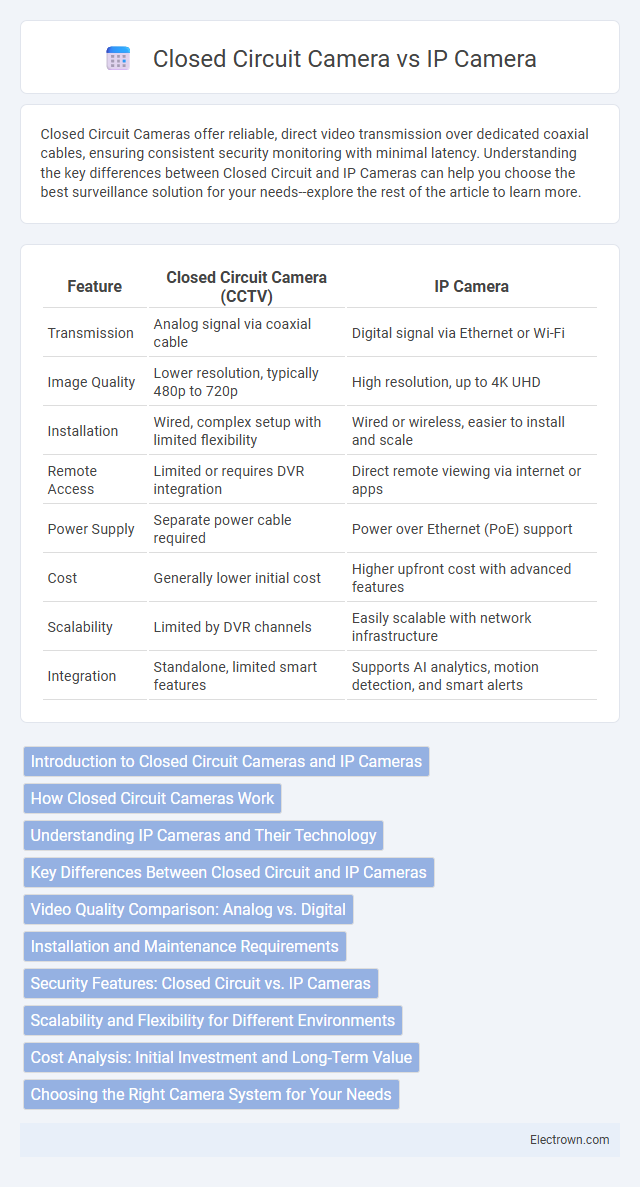Closed Circuit Cameras offer reliable, direct video transmission over dedicated coaxial cables, ensuring consistent security monitoring with minimal latency. Understanding the key differences between Closed Circuit and IP Cameras can help you choose the best surveillance solution for your needs--explore the rest of the article to learn more.
Table of Comparison
| Feature | Closed Circuit Camera (CCTV) | IP Camera |
|---|---|---|
| Transmission | Analog signal via coaxial cable | Digital signal via Ethernet or Wi-Fi |
| Image Quality | Lower resolution, typically 480p to 720p | High resolution, up to 4K UHD |
| Installation | Wired, complex setup with limited flexibility | Wired or wireless, easier to install and scale |
| Remote Access | Limited or requires DVR integration | Direct remote viewing via internet or apps |
| Power Supply | Separate power cable required | Power over Ethernet (PoE) support |
| Cost | Generally lower initial cost | Higher upfront cost with advanced features |
| Scalability | Limited by DVR channels | Easily scalable with network infrastructure |
| Integration | Standalone, limited smart features | Supports AI analytics, motion detection, and smart alerts |
Introduction to Closed Circuit Cameras and IP Cameras
Closed Circuit Cameras, commonly known as CCTV cameras, transmit video signals through a closed network, providing reliable surveillance with limited external access. IP Cameras use internet protocol to send digital video over networks, allowing remote monitoring and higher resolution imaging. Choosing between CCTV and IP cameras depends on your specific security needs, budget, and desired level of connectivity.
How Closed Circuit Cameras Work
Closed Circuit Cameras operate by transmitting video signals through coaxial or twisted-pair cables directly to a monitor or recording device, ensuring a secure, localized surveillance system. These analog cameras capture footage in real-time, which is then displayed on dedicated screens without needing internet connectivity. Their wired infrastructure minimizes latency and potential hacking risks compared to IP cameras, making them ideal for closed environments.
Understanding IP Cameras and Their Technology
IP cameras utilize digital networking technology to transmit video data over the internet or local networks, enabling remote access and real-time monitoring. Unlike Closed Circuit Cameras that rely on analog signals and direct wired connections, IP cameras offer higher resolution, advanced features like motion detection, and scalability through wireless or wired connections. Their integration with cloud storage and mobile apps enhances security management by providing flexible and efficient surveillance solutions.
Key Differences Between Closed Circuit and IP Cameras
Closed Circuit Cameras transmit video signals directly to a specific monitor or recording device through coaxial cables, ensuring a reliable, low-latency connection ideal for localized surveillance. IP Cameras use internet protocol to send and receive data over a network, enabling remote access, higher resolution footage, and advanced features like motion detection and analytics. Your choice depends on factors like installation complexity, scalability, and whether you need real-time remote monitoring or straightforward on-site security.
Video Quality Comparison: Analog vs. Digital
Closed Circuit Cameras typically deliver lower video resolution due to their analog signal format, often capped at 960H or 720p, resulting in grainier and less detailed footage. IP Cameras leverage digital technology to provide higher video quality, supporting resolutions of 1080p, 4K, and beyond, which enhances image clarity and allows zooming without significant quality loss. Your choice between these systems significantly impacts video clarity, with IP Cameras offering superior detail for precise monitoring and identification.
Installation and Maintenance Requirements
Closed Circuit Cameras typically require complex wiring and dedicated monitors, making installation more labor-intensive and maintenance involves checking physical connections regularly. IP Cameras offer easier installation with wireless capabilities and remote access, reducing the need for extensive wiring and simplifying updates or troubleshooting. Your choice impacts installation time and ongoing maintenance efforts, with IP cameras generally providing more flexibility and lower long-term costs.
Security Features: Closed Circuit vs. IP Cameras
Closed Circuit Television (CCTV) cameras offer localized security with direct connections, minimizing vulnerability to cyber-attacks but limiting remote monitoring capabilities. IP cameras provide advanced security features such as encryption protocols, user authentication, and remote access, enabling real-time surveillance and integration with intelligent analytics. The choice depends on balancing physical security with network security requirements and the need for scalable, flexible monitoring solutions.
Scalability and Flexibility for Different Environments
Closed Circuit Cameras offer limited scalability, typically requiring extensive wiring and hardware adjustments for system expansion, making them less adaptable for dynamically changing environments. IP Cameras provide superior flexibility and scalability by utilizing network infrastructure, allowing seamless integration of additional units and remote management across diverse environments, from small offices to large campuses. Their ability to leverage existing Ethernet networks significantly reduces installation complexity and supports advanced features like remote viewing and analytics, fitting diverse surveillance needs efficiently.
Cost Analysis: Initial Investment and Long-Term Value
Closed Circuit Cameras (CCTV) typically require a lower initial investment compared to IP Cameras due to simpler infrastructure and hardware costs. However, IP Cameras offer greater long-term value through advanced features like remote access, higher resolution, and easier scalability, which can reduce maintenance and upgrade expenses over time. Evaluating Your security needs against these cost factors helps determine the most cost-effective solution for both immediate and future surveillance requirements.
Choosing the Right Camera System for Your Needs
Choosing the right camera system depends on your specific security requirements and installation environment. Closed Circuit Cameras (CCTV) offer reliable, real-time monitoring with wired connections, ideal for fixed locations requiring stable, tamper-proof surveillance. IP Cameras provide greater flexibility with wireless setup, higher resolution, and remote access, making them suitable for businesses or homes needing scalable, high-quality video and integration with smart devices.
Closed Circuit Camera vs IP Camera Infographic

 electrown.com
electrown.com